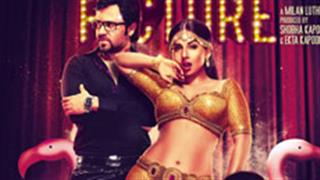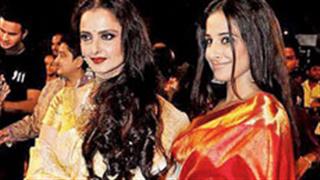Vijayalakshmi, a poor Andhra girl, who morphed into ‘thunder-thighs' Silk Smitha, began as a make-up man's assistant. Soon she became a top draw at the box office with her sexy dance numbers in around 450 Southern films.
Mumtaz was a junior artist, a sophisticated term for a film extra in the early 1960s. She accepted small roles in big films like Mujhe Jeene Do and big roles in small budget stunt films like Boxer, Samson, Tarzan, and King Kong.
In the 1960s, she starred in as many as 16 action films with freestyle wrestler Dara Singh and was labelled a heroine of stunt films. Her first hit was as a vamp in Mere Sanam (1965). Her big break came with Ram Aur Shyam (1967) where she played one of the two heroines of Dilip Kumar. The film was among the top box office grossers of the year.
Meena Kumari wanted to go to school. But father Ali Baksh, reportedly could not pay the fees of the doctor who delivered her and left her at a Muslim orphanage only to pick her up after a few hours.
Her name was changed from Mahajabeen to Baby Meena when she made her debut at seven in Farzand-e-Watan (1939). She became the sole breadwinner of her family of two elder sisters and parents.

The story of Johnny Walker reads like a film script. Christened Badruddin Jamaluddin Kazi, he was the son of a mill worker who, after migrating to Mumbai, found it difficult to maintain a family of 15. Badruddin tried different jobs to join the Bombay Electric Supply and Transport (B.E.S.T.) as a bus conductor.
While clipping tickets, he would entertain the passengers with amusing antics. This caught the attention of an important passenger, Balraj Sahni in 1950. An impressed Sahni introduced him to Guru Dutt then casting for Baazi.
Dutt took him on and gave him his starry name Johnny Walker after the famous whisky brand. Though he mostly portrayed the role of a drunk, he never touched alcohol in real life. His most memorable performance was in Hrishikesh Mukherjee's Anand.
Filmmaker-actor Guru Dutt's early childhood was spent within the cramped space of a small flat in Matunga in Mumbai. His father shifted from one job to another, leaving the family in a perpetual state of economic instability.
Sunil Dutt was so poor that he had to sell off his collection of Shakespeare after his graduation exams in Mumbai to make ends meet. Rajendra Kumar had to struggle for nine years till he got his first big break.
Jackie Shroff's first role was as the villain's henchman in Dev Anand's Heera Panna (1973). B. R. Ishara who directed Chetna (1970) dusted the canteen tables at Sree Sound Studios in Mumbai. Ram Gopal Verma, a civil engineer by education, chose to rent out CDs and VCDs in Ameerpet in Hyderabad. A chance meeting with cinematographer S Gopal Reddy changed the course of his life.

Such fairy tales seem to have faded into oblivion today. Bollywood has become a dynastic world where sons and daughters carry their fathers' and mothers' flag forward.
The story of film personalities rising from dust and disappearing to dust ended when Shobhana Samarth produced Hamari Beti (1950) to launch her eldest daughter Nutan as leading lady. Nutan was only 14 then. Nutan's sister Tanuja followed suit. Today, the industry raves over Kaajol, the third generation star-actress from the same family.
Before that, Raj Kapoor, the eldest son of actor-director Prithviraj Kapoor, made his debut opposite Madhubala in Neel Kamal (1947). A year later, formed his own company to make Aag released in 1949. The fourth generation of Kapoors has struck gold in the name and style of two beautiful women – Karishma and Kareena.
Beauty contests like Miss India, Miss World and Miss Universe are another channel that have given birth to many Bollywood stars today. The first taste of success came with Zeenat Aman and Tina Munim.
They were followed by Meenakshi Sheshadri, Juhi Chawla and Poonam Dhillon. Sushmita Sen, Neha Dhupia, Gul Panag, Celina Jaitley and Diya Mirza followed but were soon reduced to also-rans with brand endorsements seeing them through or, small banners with little or no success.
But Priyanka Chopra and Aishwarya Rai have left the others far behind. Modelling is another channel. John Abraham, Sudhangshu Pandey, Sonu Sood and Mukul Dev stepped in through this door.

Elite families have brought in wonderful talent. Sharmila Tagore was the first to raise the bar. Now two of her three kids are stars in Bollywood.
The best examples of great bloodlines are Shabana Azmi, daughter of Kaifi and Shaukat Azmi, Amitabh Bachchan, son of littérateur Harivansh Rai Bachchan, Nandana Sen, daughter of Nobel Laureate Amartya Sen and Deepika Padukone from the badminton family of Prakash Padukone.
Bollywood is now a land for the social elite and for those who can afford expensive education at the many film institutes that have sprung up like mushrooms across the country. The FTII, Pune, where the fees have become astronomical by middle-class standards, is churning out the best of technicians every year.
But there are a few exceptions where family ties never existed, nor did they rise from the bylanes of poverty. Yet they are big names in the industry today.
Rajesh Khanna, Shatrughan Sinha, Shahrukh Khan, Vidya Balan, Akshay Kumar, Katrina Kaif, Kangana Ranaut and Urmila Matondkar have come out of their middle-class background to make their point.
Yet, the fact remains that no producer or director will ever think of making a feature film on any of the silver-spooned -from Salman Khan to Hrithik Roshan through Amir Khan or Sonakshi Sinha and Sonam Kapoor 20 years from now. Why? Because their ‘struggles' and ‘life stories' are too damn boring!
















